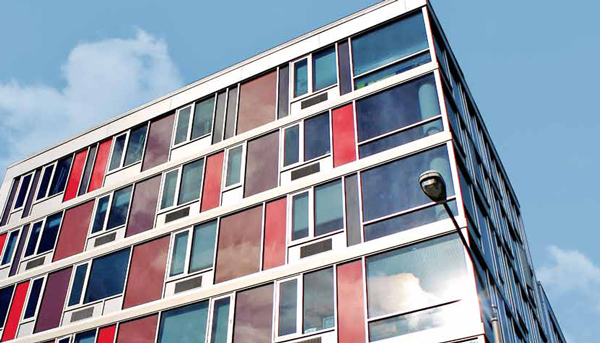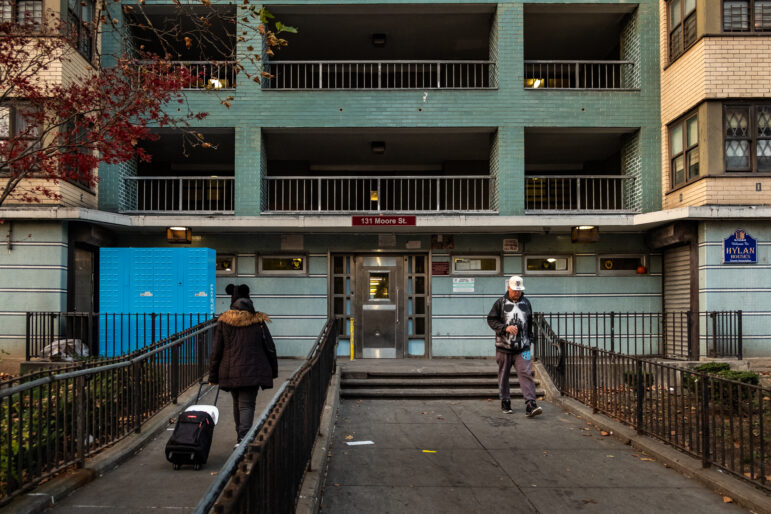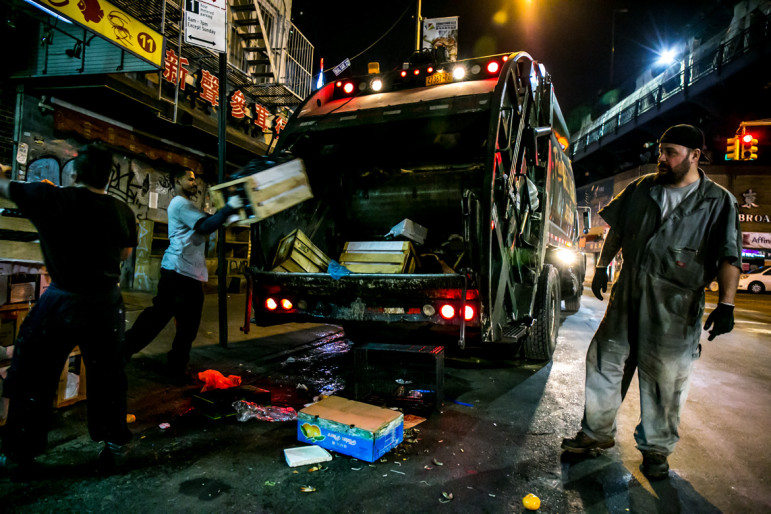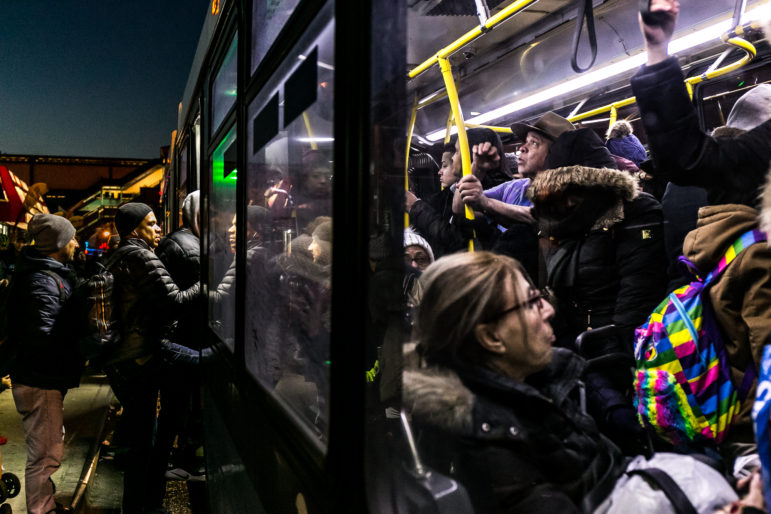
Photo by: Adi Talwar
A sparkling luxury high-rise–the new face of Williamsburg after a controversial 2005 rezoning.
It’s a strange walk down North 7th Street in Williamsburg on a weekday morning these days. People pour into the L train station on the corner of Bedford Avenue, and the bikes locked around posts and poles are so abundant, it can be hard to move down the sidewalk. It looks like boom time.
But then you pass a stalled building site. And then another. You turn the corner and see a whole block that is empty. You round another block and notice one factory building after another that is gated, out of use. Move toward the waterfront and you see towering high-rises that appear to be only half full. Yet others are still going up.
The rash of residential development, spurred by a 2005 rezoning, is behind much of it: the bikes, the high-rises, empty lots and closed factories, where owners ousted industrial tenants in search of the bigger bucks that residential development might bring. “We call this one Jurassic Park,” says Phil dePaolo, a home audio consultant by day who sidelines as an inveterate community activist and gadfly. “There was a place called Oriental Food Supply. It was great. You’d come in here and buy fresh bok choy.” Now it’s an empty spot in a vacant lot. The rezoning of the area to a midrise residential district totally changed the Williamsburg real estate market. “Once that happens, the land values just skyrocket,” says dePaolo.
This is not what Williamsburg and Greenpoint asked for. In fact, it wasn’t what they planned for. A decade ago, these neighborhoods took the city up on an offer to plan proactively for their future. They spent years crafting a vision of what should happen. The city accepted and approved it.
But when developers wanted access to a two-mile stretch of the Brooklyn waterfront and some of the hipster interior of the new Brooklyn, the City Planning Commission simply disregarded much of what the community wanted.
If New York City is going to approach its future in a thoughtful way—planning rather than just zoning, thinking comprehensively, considering not just where the buildings go but also where to put schools and how to improve transit—it will have to solve the riddle it has wrestled with for nearly 60 years: whether and how to involve communities in planning their future.
In 1951, Manhattan Borough President Robert Wagner established 12 community planning councils to advise him on land use and budget decisions. After Wagner became mayor and the City Charter was revised in 1963, the concept went citywide. In 1976 the boards’ role in the city’s land use process was strengthened—the idea being to try to let a layer of government closest to the people guide the planning that affects communities.
Today, there are 59 community districts in the city, and each has a community board. A board has up to 50 volunteer members—half appointed directly by the borough president, half recommended by the local City Council members and approved by the BP—serving two-year terms. The board chairman is elected by the board members, who also hire a district manager who works full time for the community board.
The community board is the first stop in the city’s process for reviewing land use proposals like zoning changes. It also helps monitor the delivery of city services like garbage pickup and police protection. And every year it submits a “statement of needs” that is supposed to inform the city’s budget process.
When the charter was revised again in 1989, community boards were given a key power: the right to propose a plan “for the development, growth and improvement” of its district, called a “197-A plan,” for the section of the charter that grants the power.
“Let’s put it this way: The community has more influence, on paper, than it ever did,” says Paul Graziano, the planner. “However, there’s a caveat with that: That’s for areas that are not on the radar for upzoning or for more intensive redevelopment.”
Williamsburg and Greenpoint began work on 197-A plans in the mid-1990s. The plans were approved by the city in 2002. Their goal was to reclaim the waterfront— which had been plagued by heavy, noxious industry—for open space and low-rise, affordable residential development. New transit options were proposed for an area traditionally poorly served by the MTA. And protecting light industry in the interior of the neighborhood was another key principle.
Less than two years later, the City Planning Commission proposed a 183-block rezoning plan that differed significantly from what the 197-A plan called for. The housing on the waterfront was made far higher than the community wanted. The plan’s hope to hang on to historic buildings was not addressed. There was inadequate provision for affordable housing. And residents worried that the city’s desire to create “mixed-use” districts to serve both residential and industrial tenants was not going to do enough to protect industry. The community board voted against the plan 37-0. The borough president also did not approve the plan.
But under the ULURP process, those votes are advisory. And for the most part, the City Planning Commission didn’t take the advice. In a report issued at the March 2005 meeting where the Planning Commission approved the Greenpoint-Williamsburg rezoning, the Department of City Planning pointed to benefits in its rezoning plan, like a 28-acre waterfront park. It noted that the initial rezoning proposal had been tweaked slightly to protect some areas. And, City Planning pointed out, the department did develop the city’s first “inclusionary zoning program,” which offers developers higher buildings and public subsidies if they included affordable apartments, specifically for the Greenpoint- Williamsburg rezoning. Still, the changes didn’t much resemble what the community had asked for in its 197-A plan.
That 197-A plan “served as an important basis for DCP’s planning and laid the groundwork for an extensive public outreach process,” City Planning continued in its report. “The Commission acknowledges the importance of the 197-A plans as a guide to policy and believes they serve as valuable foundations for the proposed rezoning plan. The Commission observes, however, that conditions have continued to change within these neighborhoods since the 197-A plans were adopted.”
City Planning, “which had blessed the 197-A plan, totally fucked that neighborhood royally,” Graziano says. “They did not want 40-story buildings on the waterfront. They did not want the manufacturing district turned residential. They threw the 197-A plan in the garbage.”
Not long after that, Community Board 9 in northern Manhattan submitted a 197-A plan covering a swath of West Harlem. Among other things, the plan wanted to prevent Columbia University from using eminent domain to drive residential and industrial uses out of an area just north of 125th Street. City Planning sat on the community’s 197-A plan for a year while Columbia prepared its own plan. The final plan gave Columbia what it wanted, and the university agreed to provide community benefits in return.
Years earlier, when Manhattan Community Board 6 completed its 197-A plan, it called for the new East River Science Park to be used solely for scientific and medical uses. “The first thing the Economic Development Corp. did was to put a proposal out for a hotel,” says CB6’s land use chair, Ed Rubin. The 197-A plan, he says, “is only a statement of policy. They can ignore it, and they do all the time.”
A veteran City Planning administrator does not dispute that description. Indeed, the department is just doing what the charter says it’s supposed to do. “The 197-A plan does establish a framework for future action. We’re not slaves of the 197-A framework,” he says.
City planning does need to think about the citywide issues—housing, economic development— that a single community might not care to contemplate. Critics just find it odd which issues get citywide priority (housing, for instance, as opposed to retaining industry) and which groups get a hearing on them. New York certainly needs to retain and expand institutions like Columbia. But how should the desires of big institutions and developers be weighed versus those of residents? “Our view is that no proposal trumps the other,” the City Planning administrator says.
In the two decades since 197-A plans were created, only eight of the city’s 59 community boards have produced one. One was withdrawn. Another, from CB11 in northeastern Queens, was rejected; according to Queens Civic Congress head Sean Walsh, who drafted the plan, it was deemed unacceptable because it called for the rezoning of Northern Boulevard, which is seen as a major artery on which citywide policies— rather than community desires—hold. “The bottom line is that City Planning owns all the chips: their cards, their house, their chips,” he says. And “to get something on their agenda may take years.”
Some boards who’ve done 197-A plans are very happy with the results. At CB8 in Riverdale, chairman Damian McShane says, “Overall, City Planning was very good to work with.” While CB8 didn’t get everything it wanted, “what we were able to do was in large swaths of the community, we did downzoning where there were existing single-family homes,” McShane says.
Even Walter South, the landmarks and preservation chair of the Manhattan board that tried and failed to rebuff the harsher parts of Columbia’s plan, says the 197-A effort has helped in other parts of the neighborhood. “We are now in the process of doing a contextual zoning for the area north of 135th Street,” he says. “Landmarks has just announced that they are willing to consider a Morningside Heights historic district. We were able to get a lot of things on the table, to get things approved.”
But 197-A plans have not created the comprehensive, community-based planning they promised. “The real problem with the 197-A plans is not so much City Planning. It’s that it is a small hurdle in a developer’s road,” Jerome Armer, who sat on Brooklyn’s CB6 for nearly 30 years, says. “Any good developer will know what he has to do to jump the hurdle.”
Some communities do succeed in persuading City Planning to change its mind. Deborah Ayala, the president of the Jamaica Hills Community Association, has worked with City Planning on a number of rezonings since 1990. “They were very, very helpful when we said, ‘Listen, the zoning wasn’t going to work.’ We were one of the first civics that were able to have City Planning create a whole new zone for us. They were wonderful.”
The communities and community boards that get heard are those that have a good relationship with their Council member—since he or she has an informal veto over projects in the district—and demonstrate political heft. James Vacca, a councilman who previously served as district manager for Bronx Board 10 for 26 years, recalls a time in 2003 when Mayor Bloomberg came to Throgs Neck for a town hall meeting. “We made sure people were there,” he says, to demonstrate the neighborhood’s strength. This helped Throgs Neck get the downzoning it desired.
But even relatively muscular community boards carry little weight. Each is but one of 59 boards across the city and has merely advisory powers. This is why, rather than saying “no” to a land use application, community boards often vote “yes” but attach conditions. The City Planning Commission is free to ignore those conditions, and it often does, but boards view it as the only way to stay relevant to the process.
“Community boards who vote’ no’ are typically labeled NIMBY,” says Vacca. By the time a land use idea gets into the ULURP process and comes to a community board, he says, City Planning has probably already decided it is something it supports. “The reality is, at the end of the day, the application will very likely be approved.”
Money matters too. The City Charter says the Department of City Planning is supposed to “provide community boards with such staff assistance and other professional and technical assistance as may be necessary to permit such boards to perform their planning duties and responsibilities.” But the city has never done that.
The Department of City Planning does not enjoy abundant resources. Despite being tasked with having to plan a city that has grown by more than a million people since 1981, City Planning has lost 36 percent of its workforce since then.In recent budget cuts, City Planning suffered dearly—absorbing cuts of nearly 5 percent this year, when the overall city budget shrank by only 2.5 percent. Oddly, City Planning has said these cuts are not a problem. According to a fiscal 2011 budget document, when the City Council asked City Planning about the impact of losing 15 percent of its staff in the past two years, the agency “stated that despite this loss in total staff, it has enough resources and capacity to meet the agency’s objectives.”
Over the past 20 years, community boards have enjoyed modest growth in budget and head count, but each still has very little to spend: Manhattan Board 10, for example, serves more people than live in Green Bay, Wis. But Board 10’s $279,000 annual budget is substantially less than what Green Bay’s Department of Economic Development spends in a year.
The inadequate funding of the community boards creates inequities between boards that serve wealthy neighborhoods and those that cover lower-income areas. “We’re a relatively affluent neighborhood,” says Rubin of Manhattan Board 6. “We were able to hire lawyers and a planning firm” for the 197-A plan process. “It’s very hard for a poor district to develop 197-As.” A 197-A plan takes years to complete and requires the help of a professional planner, which can cost upwards of $100,000. This is why some community boards don’t bother with the chief tool for comprehensive, community-based planning that New York City has to offer. “I felt the 197-A represented a very general look at your district,” Vacca says. “It takes years, and at the end of the day, it’s advisory. Community boards want something that is more than advisory.”
Any discussion of community input runs into the tricky task of deciding whose voices need to be heard. “What is ‘the community’?” asks longtime environmental justice advocate Eddie Bautista. “It differs depending which councilperson you talk to.”
Community boards are not universally loved. With borough presidents picking their members, community boards do not enjoy political independence. This has been demonstrated in recent years when community board members who voted against projects that were priorities for borough presidents found themselves removed from the board when the next round of appointments came. When eight members of a Bronx board voted against the Yankee Stadium project, which then BP Adolfo Carrión strongly supported, three rebels and the chairman were disinvited from the board.
The Atlantic Yards project circumvented the ULURP process, but Brooklyn Board 6 opted to weigh in on it anyway. “We came up with a critique which basically supported Atlantic Yards but felt that there were aspects of it that were a bit large and recommended that the development around the actual arena be scaled back or made more realistic,” recalls Armer, who had been on the board since the 1970s. For that, Brooklyn Borough President Marty Markowitz did not reappoint Armer and four others to the board.
Vincent Morgan, the chairman of the 125th Street Business Improvement District, was deeply opposed to the 2008 rezoning of the 125th Street corridor that allowed for massive residential development in an area already under threat from gentrification. Two local community boards gave conditional approvals of the rezoning; one a conditional disapproval. Morgan was particularly worried about what would happen to Harlem’s cultural institutions. City Planning developed a zoning bonus to protect those gems, but Morgan and others doubt it will succeed. As troubling as the product of the rezoning push was, Morgan says, the process was even worse. “I think that a lot of times, we fool ourselves into thinking there’s this open process. It’s who puts the process together that control who gets access, who gets listened to and who doesn’t,” he says. “The community boards are stacked and are little political entities all on their own.”
But there are ways to make community boards work better. When he was running for Manhattan borough president five years ago, Scott Stringer released a report finding multiple flaws in the way community boards were composed and operated. The process for appointing members was “politicized and unsystematic,” he found, leaving multiple vacancies and leading to boards whose membership was out of whack with the demographic makeup of the neighborhood. What’s more, ethics rules, oversight, training and assistance were absent.
When he took office, Stringer implemented a menu of reforms to make boards work better. His staff holds regular information sessions and talks to community groups about the opportunity to join a community board, targeting that outreach to communities that are underrepresented on the current boards. He’s had the community board membership application translated into five languages, enlisted 5,000 neighborhood organizations to distribute them and impaneled a committee to advise him on appointments. Stringer also launched a fellowship program to pair planning students with boards, an attempt to close the expertise gap between what boards need and what the city is willing to fund. Stringer says his reforms have helped to reduce the board vacancy rate from 25 percent to zero.
Stronger community boards have an ally in the corporate community. “From the business community standpoint, a strong community board structure is seen as a good thing and a source of stability and predictability,” says Partnership for New York City president Kathy Wylde.
That’s because community boards are easier to deal with than are some of the ad hoc coalitions that have sprouted to negotiate community benefit deals with major developments. If businesses have to deal with the community, they’d rather it be in a forum whose rules and players they know. Right now, says Wylde, “Investment is discouraged by large uncertainty factors and the sense that decisions are not based on an underlying plan or a long-range planning consideration.”
Bob Yaro, the president of the Regional Plan Association, disputes the notion that community input is undervalued by the City Planning Commission: “They get criticism from both sides, that they haven’t engaged enough, that they are too responsive to the community, that outcomes have been shaped by NIMBY. They’ve probably struck the right balance if both sides are criticizing them.”
It’s true—sometime communities can ask for a lot. Westerleigh, in Staten Island, was rezoned in 1989 to reduce the density of residential development. It was downzoned again in 2003. In 2005 they pushed for a third round of density reduction. “We wanted the area rezoned to R2. Some of the limitations of R3 permitted developers to squeeze in more housing than we were comfortable with,” says Michael Morrell, head of the Westerleigh Improvement Society. This third round of downzoning “was going fine until it met the desk of the chair, Amanda Burden,” Morell says. “We were just confronted with a stone wall. She claimed that the area was suitably zoned.”
Ultimately, Westerleigh got the downzoning it asked for. But it exposed the City Planning Commission, which was simultaneously upzoning big swaths of the city, to the charge that it was overly concerned with the needs of Staten Island homeowners. Pleasing everybody is hard.
“My concern is that most folks and most communities are inherently conservative,” says Ken Fisher, the land use lawyer. “So if you were doing a 197-A plan in certain neighborhoods of Brooklyn when I was growing up, the thrust of it would have been to figure out how to keep those neighborhoods as white as could be.”
But the content of community involvement is almost a secondary concern, Fisher says, to the problems with how the process works today. “What makes developers crazy is a lack of certainty on how long things are going to take,” says Fisher. ULURP is time-limited to around seven months, but the period before the ULURP clock starts can span years. Paradoxically, it’s the larger projects—the ones communities worry about the most—that are best equipped to deal with the cost overruns and legal bills that a drawn-out process generates, he says. “Smaller projects often languish.”
Allies of developers seem to see an entirely different planning system than community members experience. “There is so much room for input along the way, and that same room for input, I think, sometimes that overwhelms people,” says Melinda Katz, the former Council land use committee chair, who now works in land use law.
So how can developers be upset at the amount of community input while community members complain that they don’t have a voice?
The confusion is in the difference between input and influence. Getting a say and getting your way—or, at least getting some of what you asked for—are two different things. A developer faces two rounds of public comment on the environmental review, ULURP hearings at the community board and borough level, a City Planning Commission hearing and a City Council session. That seems like a lot of community involvement. But while there are ample opportunities to speak, a community has little real sway within that process. “The City Planning Commission thinks they do plenty of community input,” says Roberta Brandes Gratz, author of the book “The Battle for Gotham: New York in the Shadow of Robert Moses and Jane Jacobs.” “The problem is they go to a community with a plan, and then they get the community to react,” Gratz says. “That’s not community input. Community input is when the community is involved in making the plan.”
When Mayor Bloomberg went to the Queens Museum in December 2006 to unveil the first stage of PlaNYC, he said the city was “going to go to the real experts—you. New Yorkers in all five boroughs” to help draft the document.
The administration did engage the public. “There were dozens of meetings with advocacy groups, civic group,” says Eddie Bautista. “As I was there, I saw the plan evolve and change with people’s input.” But when you consider that PlaNYC set out to address everything from housing to open space to energy to transit for the next quarter-century, three months was a pretty small window of opportunity for community members to be involved. “The thing with PlaNYC was, we did as much [community outreach] as we could with the time we had,” says the former PlaNYC staffer. “We did it with no budget.”
While PlaNYC has chalked up dozens of accomplishments, its early life was dominated by a signal failure—the collapse of the congestion-pricing proposal. The lack of grassroots support for the mayor’s traffic fee is one explanation for its demise. Indeed, says the Municipal Art Society’s David Shackenberg, “One of the things about PlaNYC is it’s top-down.” He adds, “A meaningful comprehensive plan—if it’s possible—has to come from disparate points and has to reflect different neighborhoods and neighborhood perspectives. It can’t be a mayoral-driven, top-down plan.”
The Bloomberg administration is now working on an update of PlaNYC. In late October, at a sparsely attended community input session at Lincoln Hospital in the Bronx, PlaNYC organizer Ibrahim Abdul-Matin suggested the second round of PlaNYC would aim to correct a flaw in the first one—the fact that the mayor set the goals without asking New Yorkers if they shared them. “PlaNYC is a citywide plan, but it’s also a neighborhood plan,” he said. “This is where we want you to think with us. Is this a good goal? Is it a meaningful goal? Is it a practical goal?”
The October meeting was just one step in an outreach process that will involve community groups, community boards, borough presidents and another round of public hearings. But so far, the meaningful impact of community input seems pretty limited. “This is not enough time to get out every idea that you have,” Abdul-Matin told the crowd at Lincoln Hospital, and he was right. When the meeting broke into groups around specific policy areas, there was about 20 minutes to talk about big-ticket topics like “transit” and “waste.” Participants were discouraged from talking about specific policies and told to focus on crafting broad goals.
At one table, someone suggested that public input was an important part of developing a better transit system and a better PlaNYC. “This is something that we hear consistently at every meeting,” the facilitator agreed, “the need for more consistent and more thorough community involvement.”
New York City doesn’t need to invent a system for urban comprehensive planning out of thin air. Plenty of cities offer different models for how to do it. In Houston, it’s called Super Neighborhoods, in which elected neighborhood boards create plans that determine where capital spending goes. In Buffalo, the Good Neighbors Planning Alliance links community plans generated in each neighborhood to capital and program budgets. Seattle sets growth targets and then asks neighborhoods how to reach them; the resulting plans are tied to city spending and managed through a citywide council led by citizens.
In Portland, Ore., an effort is now under way to create the Portland Plan, tying together public spending, local codes, laws and growth planning. Because Oregon’s statewide land use planning system requires citizen involvement, community participation drives the Portland process. The beginning of the six-year effort was a two-year community visioning process that involved 17,000 people (the equivalent of 270,000 people in New York City). Linda Nettlekoven, a member of the committee overseeing community participation, says the community input has not been perfect—”We struggled with being too white, too homeownerfocused, etc. The people who tend to have easier lives have more time to participate”—but the city has given grants to the local Latino Network and Urban League to run training programs to get members of other communities involved.
None of these other cities’ approaches seem incompatible with New York’s existing community board structure. And none of them would doom New York to a useless exercise in master planning. “I remember the 1969 master plan being used for people to kind of sop up water,” says Ronda Wist, senior director of planning and advocacy at the Municipal Art Society. “A comprehensive plan may be impossible because of what New York is,” she says. “But it’s possible to set up a comprehensive planning framework.” One plan might not work for the whole city, but a collection of community plans covering the entire map could.
During the brief period this summer when it looked as if the Charter Revision Commission would consider major changes to the land use process, several sets of policy proposals emerged from players on the planning scene. Taken together, they draw a pretty clear road map for how New York City might do planning better.
One was that community boards need resources to do their jobs. “Over time, the community boards became service delivery mechanisms, even dropping planning from their name,” says Manhattan Borough President Stringer. “We need to look at how we plan in this city. We think that every community board must have a planner working with the board.” One way to do this, says Citizens Union, would be to create a pool of independent planners who can work with different boards. An alternative approach would be to give each board a small but guaranteed portion of the overall city budget.
Another clear theme was that an independent planning authority is needed. The Pratt Center calls for separating the jobs of Department of City Planning Commissioner and head of the City Planning Commission; the current combination of those titles means that Amanda Burden directs consideration of what her own department has prepared. Hunter College’s Tom Angotti suggests putting the public advocate in charge of overseeing the land use process citywide. Stringer has called for the creation of an Independent Planning Office “to look at the issues in a more macro way.”
“The City Planning Commission does a good job in managing and shaping individual projects,” he says, “but they are not empowered to do a lot of the critical thinking that we need to do.”
A third strand is the desire to encourage comprehensive planning by communities by giving the 197-A process teeth—or at least dentures. “197-A plans should be submitted to all relevant City agencies and such agencies should formally review and respond to such plans, and integrate them as much as possible in their policies,” is what Stringer’s report recommends. “Any departure in agency policy from an approved 197-A plan should be justified in writing with an opportunity for the community board and public to respond. All ULURP actions should also require consideration of integrating 197-A plans when practicable and any inconsistencies should be formally justified in the application materials.”
Angotti goes a step further: He’d require community boards and city agencies to submit 197-A plans. Taken together, these would form a comprehensive plan for the city.
For any of these changes to take place, another charter revision commission would need to be impaneled. That’s the mayor’s call.
The mayor’s Department of City Planning, which did not comment for this piece but directed City Limits to community advocates who’d worked with it, does not want to see broad changes in how the city plans. The agency defended ULURP in its testimony to the City Planning Commission this summer. “It is slow, but it is predictable and also allows sufficient time for issues to both percolate and to get resolved,” said David Karnovsky, the agency’s chief counsel. “It allows for a balancing of local, borough and citywide concerns.”
Luckily, almost none of the calls for change this summer advocated the abolition of ULURP—and none would have stripped City Planning of the flexibility it needs to square the desires of individual neighborhoods with citywide demands. “I don’t think anybody wants a plan to be law, precisely because things change,” says Pratt’s Eve Baron. “You don’t want to be bound to create 20,000 units of housing if the growth changes drastically.”
What’s been called for, instead, is to give all the city’s neighborhoods a real reason and the real resources to plan, so citywide issues don’t need to be solved one project at a time; so decisions on where to build might have some linkage to transit, schools, jobs and other parts of life in the city; so communities have an option other than NIMBY and developers have a real road map for what neighborhoods will tolerate. That way, more people have an incentive to engage in the municipal government’s most fundamental task: deciding what to do with the blocks and buildings that make up New York City.
When, in 1990, the city proposed demolishing much of the Bronx neighborhood of Melrose, located a few blocks east and south of Yankee Stadium, and replacing it with a middle-income development that would have priced-out incumbent residents, many in the neighborhood rebelled. They organized, protested and demanded something different: a smaller plan that had the explicit








